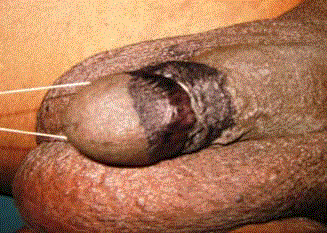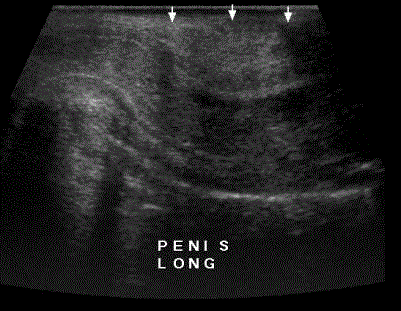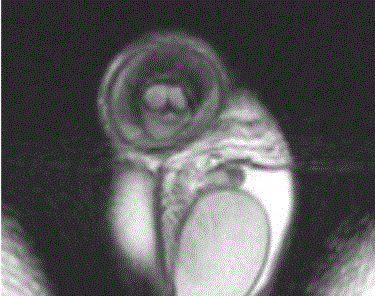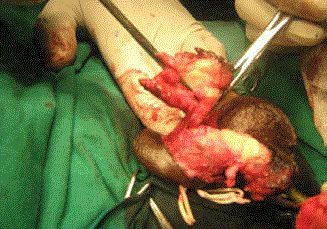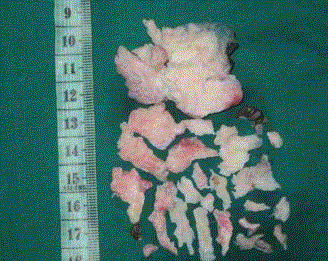Case Report
An Unusual Case of Circumferential Peyronie's Disease
Sanish Shringarpure*
Department of Urology, Apollo Hospitals, India
*Corresponding author: Sanish Shringarpure, Department of Urology, Apollo Hospitals, Chennai, Tamil Nadu, India
Published: 02 Nov, 2017
Cite this article as: Shringarpure S. An Unusual Case of
Circumferential Peyronie's Disease.
Clin Surg. 2017; 2: 1707.
Abstract
Peyronie’s disease is a rare connective tissue disorder. We report the case of a 60 year old male, who came to us with circumferential peyronie’s disease plaque involving both the corpora cavernosum. He had a recurrence of Peyronie’s disease which had initially presented as a single small plaque on the dorsal aspect of the penis which was surgically excised three years back. He had excruciating pain at rest and erection not relieved by medicines. He underwent surgery for removal of the entire plaque with dermal grafting which relieved his symptoms totally.
Introduction
To our knowledge, only 2 case reports in the literature documents a Peyronie plaque involving the entire tunica albuginea of the penis. This report documents the case of a living patient with a Peyronie plaque involving the entire tunica albuginea of the penis. So, we describe this particular case for this rare presentation.
Case Presentation
A 60-years-old male presented to us with the complaints of a hard plaque on the penis, which
was gradually increasing in size and extent since past 3 years. He gives a history of a single small
plaque on the dorsal aspect of the penis at the level of coronal sulcus which was excised along with
circumcision 3 years back. It was confirmed to be Peyronie’s disease on pathology. Now he was
having a recurrence of the disease which was extending to involve both the corpora cavernosa. The
patient was having pain at rest and the pain was worse on erection, not relieved by medications.
Also the patient had dorsal curvature of the penis on erection. On examination, there was a thick
circumferential plaque at the level of the coronal sulcus extending distally for 2 cm onto the glans
dorsally and 4 cm onto the shaft of the penis dorsally with maximum width of 4 cm (Figure 1).
Sonography of the penis showed the presence of a hypoechogenic plaque with calcifications
measuring 5 cm × 4 cm × 2 cm present circumferentially at the level of the coronal sulcus and
extending onto the dorsal aspect of the glans and the shaft of the penis proximally (Figure 2).
Doppler penis showed good peak systolic and end- diastolic flow velocity without any vascularity in
the plaque. MRI of the penis showed circumferential hypodense plaque on extending upto the level
of tunica albuginea (Figure 3).
The patient underwent surgery where a complete circumcising incision was taken and the entire
plaque was shaved from the tunica albuginea (Figure 4, and 5). The defect was covered with a dermal
graft harvested from the thigh of the patient. The patient recovered postoperatively without any
complications with total allievation of the pain.
Discussion
Peyronie’s disease (indurato penis plastica) is characterized by the formation of fibrous plaques
within the tunica albuginea [1]. Fibrin deposition associated with microvascular injury may be the
initial step in the formation of these plaques [2].
Almost all patients have either a well-defined plaque or an area of induration that is palpable on
physical examination which 38% to 62% of the patients are unaware of. The plaque is usually located
on the dorsal surface of the penis with a corresponding dorsal penile deformity. Lateral and ventral
sited plaques are not as common but result in more coital difficulty, as there is a greater deviation
from the natural coital angle. Our patient had a circumferential plaque involving the entire tunica
albuginea of both the corpora cavernosa. Earlier only two such cases of circumferential Peyronie’s
disease have been reported in literature. Narita and coworkers described the autopsy finding of
extensive tunica albuginea involvement by a Peyronie plaque in a man who had died of metastatic
malignant thymoma [3]. Pourbagher and co-workers described the case of a living patient with a Peyronie plaque involving the entire tunica albuginea of the penis, who presented with erectile dysfunction [4].
Peyronie’s disease typically presents with one of the following 4
complaints: painful erection, penile deformity or shortening during
erection, presence of a plaque or induration on the shaft of the penis,
or erectile dysfunction. Penile pain may be present with erection or
during sexual intercourse. The pain is not severe in nature but may
interfere with sexual function. In our case, the patient had a palpable
circumferential plaque with dorsal curvature of the penis and pain at
rest and erection.
On sonography, most Peyronie disease plaques appear as
hyperechoic lesions near the margin of the corpus cavernosum and
are usually located along the dorsal aspect of the penis [5]. In the
early phase of the disease, a plaque may be hypoechoic. These lesions
may have acoustic shadows if calcium content is high, and such
shadows are detected in 33% of Peyronie disease cases. In our case,
sonography of the penis showed the presence of a hyperechogenic
plaque cms present circumferentially at the level of the coronal sulcus
and extending onto the dorsal aspect of the glans and the shaft of the
penis proximally.
Non-surgical treatment is offered to patients with pain, plaque
or deformity of less than one year. In the early stage, intralesional
and topical treatments are applied in addition to conservative medical
therapy. In recent years, however, extracorporeal shock wave therapy
has proved effective for treating Peyronie plaques [6].
Surgical treatment should be delayed until the process becomes
stabilized. Surgery is indicated in patients with stable and severe
deformity of more than one year of duration and for patients who
have penile shortening, narrowing or indentation, or a combination
of the above that preclude normal sexual intercourse. Prior to surgery,
a detailed evaluation of penile vascular and erectile function is highly
recommended. In the current era, penile implants should be reserved
for Peyronie’s patients who have severe erectile dysfunction that
does not respond to non-surgical erectile dysfunction therapy. The
surgical treatments for penile curvature are classified into 3 different
categories: tunical shortening procedures, tunical lengthening
procedures, and prosthetic procedures. In our patient, we excised
the entire circumferential plaque using a circumferential incision
followed by dermal grafting with excellent post-operative results and
correction of the dorsal curvature and allievation of the pain.
In conclusion, although a better understanding of the
pathophysiology of the disease is achieved recently, the best
alternative to treat the patients remains a dilemma. So, early diagnosis
of Peyronie’s disease and treatment according to the stage and
complication is necessary.
Figure 1
Figure 1
On examination, there was a thick circumferential plaque at the
level of the coronal sulcus extending distally for 2 cm onto the glans dorsally
and 4 cm onto the shaft of the penis dorsally with maximum width of 4 cm.
Figure 2
Figure 2
Sonography of the penis showed the presence of a hypoechogenic
plaque with calcifications measuring 5 cm × 4 cm × 2 cm present
circumferentially at the level of the coronal sulcus and extending onto the
dorsal aspect of the glans and the shaft of the penis proximally.
Figure3
Figure 3
MRI of the penis showed circumferential hypodense plaque on
extending up to the level of tunica albuginea.
Figure 4
Figure 5
References
- Hauck EW, Weidner W. François de la Peyronie and the disease named after him. Lancet 2001;357:2049–51.
- Somers KD, Dawson DM. Fibrin deposition in Peyronie’s disease plaque. J Urol.1997;157:311–5.
- Narita T, Kudo H, Matsumoto KI. Circumferential Peyronie’s disease involving both corpora cavernosa. Pathol Int. 1995;45:383–7.
- Pourbagher M, Tarunc T, Pourbagher A, Guvel S, Koc Z. Peyronie Disease Involving the Entire Tunica Albuginea of the Penis. J Ultrasoundmed. 2005;24(3):387-9.
- Balconi G, Angeli E, Nessi R. Ultrasonographic evaluation of Peyronie’s disease. Urol Radiol. 1988;10:85–8.
- Hamm R, McLarty E, Ashdown J, Natale S, Dickinson A. Peyronie’s disease: the Plymouth experience of extracorporeal shockwave treatment. BJU Int. 2001;87:849–54.

